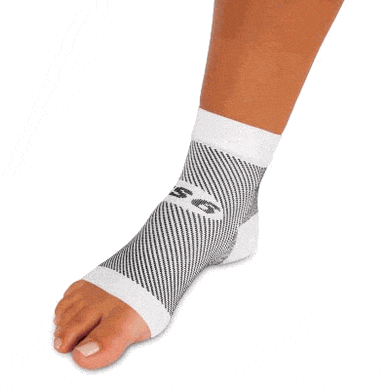Home PFTape® Plantar Fasciitis Pain Relief System
Plantar Fasciitis: Symptoms, Treatment and Prevention

In this final article in the two part series on Plantar Fasciitis, Brad Walker discusses the normal symptoms of the painful sports injury as well as the utmost effective treatments once diagnosed. Brad also describes some very important precautionary measures that are necessary to avoid Plantar Fasciitis. A feet injury such as plantar fasciitis generally occurs in a single foot. Bilateral plantar fasciitis is unconventional and tends to be the consequence of a systemic arthritic condition that is exceptionally rare among players. Males have problems with a somewhat increased occurrence of plantar fasciitis than females, perhaps as a result of increased weight coupled with greater rate and earth impact, as well as less overall flexibility in the feet.Typically, the patient of plantar fasciitis activities pain upon rising after sleep, specially the first step out of foundation. Such pain is firmly localized at the bony landmark on the anterior medial tubercle of the calcaneus. In some instances, pain may avoid the sportsman from walking in a normal heel-toe gait, causing an unusual walk as means of payment. Less common regions of pain include the forefoot, Achilles tendon, or subtalar joint.After a limited period of walking with this kind of foot injury, the pain usually subsides, but returns again either with vigorous activity or prolonged standing or walking. In the field, an altered gait or abnormal stride design, along with pain during operating or jumping activities are tell-tale signals of plantar fasciitis and should be given prompt attention. Further signs of the harm include poor dorsiflexion (lifting the forefoot off the bottom) scheduled to a shortened gastroc organic, (muscles of the leg). Crouching in a complete squat position with the only real of the ft . flat on the floor can be used as a test, as pain will preclude it for the athlete suffering from plantar fasciitis, creating an elevation of the heel due to tension in the gastroc complex.TreatmentTreatment of plantar fasciitis may also be a slow and irritating process. A program of rehabilitation should be performed by making use of someone trained and knowledgeable about the affliction. Typically, plantar fasciitis will require at least six weeks and up to six months of conservative care to be fully remedied. Should such attempts not provide comfort to the athlete, more hostile methods including surgery may be looked at.The original goals of physical therapy ought to be to increase the unaggressive flexion of the ft . and improve overall flexibility in the foot and ankle, eventually resulting in a full return to normal function. Extended inactivity in energetic sports is often the price to be payed for thorough recovery. 50 % measures can lead to a chronic condition, in some instances severely restricting athletic ability.As a big timeframe is spent during intercourse during sleeping time, it is important to ensure that the mattress sheets at the base of the bed do not constrict the feet, leading to plantar flexion in which the foot is bent straight out with the toes pointing. This constricts and in so doing shortens the gastroc organic, worsening the condition. A heat pad put under the muscles of the leg for a few minutes prior to rising may help release tension, increase blood circulation in the low leg and decrease pain. Also during sleep, a nights splint may be used in order to hold the rearfoot in a neutral position. This may assist in the recovery of the plantar fascia and ensure that the feet will not become flexed during the night.Attention to footwear is critical in avoiding ft . injuries. Every effort should be made to wear comfortable shoes with proper arch support, fostering proper foot posture. Should arch supports prove inadequate, an orthotic shoe should be considered. Fortunately, most circumstances of plantar fasciitis act in response well to non-operative treatment.Restoration times however change enormously in one athlete to some other, depending on get older, general health and physical condition as well as intensity of injury. A wide period between 6 weeks and 6 months is usually sufficient for proper curing. Additionally, the method of treatment must be versatile depending on the details of a specific athlete?s injury. Methods that demonstrate successful in a single patient, may well not improve the personal injury in another.Early treatment of foot injuries typically includes the use of anti-inflammatory medication, icing, stretching activities, and heel inserts and splints. Cortisone injections may be essential to achieve satisfactory therapeutic and retard infection. In later periods of the treatment process, typically after the first week, ice should be discontinued and replaced with heating and massage.It is crucial that any activity known to produce irritability or trauma to the plantar fascia be immediately discontinued, including any activity concerning repeated impact of the heel on a hard surface, particularly, running. Should pain from the personal injury persist, additional diagnostic studies should be carried out to eliminate other, more incredible causes of heel pain including stress fractures, nerve compression incidents, or collagen disorders of the skin.
Home PFTape® Plantar Fasciitis Pain Relief System's Wallpaper
Related Images with Home PFTape® Plantar Fasciitis Pain Relief System
Jeremy Roberts provided a lot of information about plantar fasciitis

treatment the most common surgical procedure for plantar fasciitis

Darco Plantar Fasciitis Sleeve Kansas Foot Center

Plantar Fasciitis Night Splints






0 komentar: